Related Research Articles

The illegal drug trade, drug trafficking, or narcotrafficking is a global black market dedicated to the cultivation, manufacture, distribution and sale of prohibited drugs. Most jurisdictions prohibit trade, except under license, of many types of drugs through the use of drug prohibition laws. The think tank Global Financial Integrity's Transnational Crime and the Developing World report estimates the size of the global illicit drug market between US$426 and US$652 billion in 2014 alone. With a world GDP of US$78 trillion in the same year, the illegal drug trade may be estimated as nearly 1% of total global trade. Consumption of illegal drugs is widespread globally, and it remains very difficult for local authorities to reduce the rates of drug consumption.
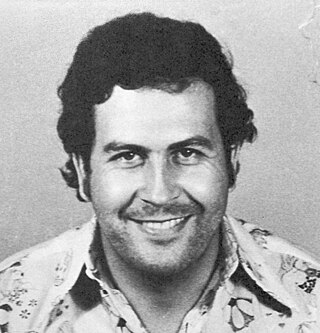
The Medellín Cartel was a powerful and highly organized Colombian drug cartel and terrorist organization originating in the city of Medellín, Colombia, that was founded and led by Pablo Escobar. It is often considered to be the first major "drug cartel" and was referred to as such; due to the organization's upper echelons and overall power-structure being built on a partnership between multiple Colombian traffickers operating alongside Escobar. Included were Jorge Luis Ochoa Vásquez, Fabio Ochoa Vásquez, Juan David Ochoa Vásquez, José Gonzalo Rodríguez Gacha and Carlos Lehder. Escobar's main partner in the organization however was his cousin Gustavo Gaviria who handled much of the cartel's shipping arrangements and the more general and detailed logistical aspects of the cocaine trafficking routes and international smuggling networks which were supplying at least 80% of the world's cocaine during its peak. Gustavo, also known as León seems to have also had a strong hand in the cartel's unprecedented acts of narcoterrorism, right alongside his cousin Pablo and was considered to be second in command of the cartel and therefore one of Colombia's most wanted men, with both him and Escobar having arrest warrants pending from other nations where their criminal activity had spread to, such as in Spain and the U.S. Meanwhile, Pablo Escobar's brother Roberto Escobar acted as the organization's accountant. The cartel operated from 1976 to 1993 in Colombia (Antioquia), Bolivia, Panama, Central America, Peru, the Bahamas, the United States, as well as in Canada.
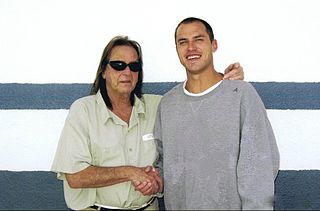
George Jacob Jung, nicknamed Boston George and El Americano, was an American drug trafficker and smuggler. He was a major figure in the United States cocaine trade during the 1970s and early '80s. Jung and his partner Carlos Lehder smuggled cocaine into the United States for the Colombian Medellín Cartel. Jung was sentenced to 60 years in prison in 1994 on conspiracy charges, but was released in 2014. Jung was portrayed by Johnny Depp in the biopic Blow (2001).
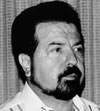
Gilberto José Rodríguez Orejuela was a Colombian drug lord and one of the leaders of the Cali Cartel. Orejuela formed the cartel with his brother, Miguel Rodríguez Orejuela, José Santacruz Londoño, and Hélmer Herrera. The cartel emerged to prominence in the early 1990s, and was estimated to control about 80 and 90 percent of the American and European cocaine markets respectively in the mid-1990s. Rodríguez Orejuela was captured after a 1995 police campaign by Colombian authorities and sentenced to 15 years in prison. He obtained early release in 2002, and was re-arrested in 2003, after which he was extradited to the United States. There, he was sentenced to 30 years in prison, where he died in 2022.
Juan Ramón Matta-Ballesteros is a Honduran former major narcotics trafficker who has been credited with being one of the first to connect Mexican drug traffickers with the Colombian cocaine cartels. This connection paved the way for a major increase in the amount of cocaine smuggled into the United States during the late 1970s and throughout the 1980s. Matta was indicted for operating several major cocaine smuggling rings in United States in the early 1980s. He was also one of the narcotics traffickers accused of the kidnap and murder of American DEA agent Enrique Camarena in 1985.
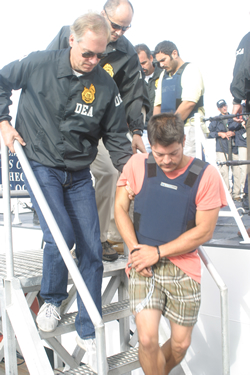
Francisco Javier Arellano Félix is a former Mexican drug lord who alongside his brothers founded and led the Tijuana Cartel until his capture by the United States Coast Guard on August 16, 2006.
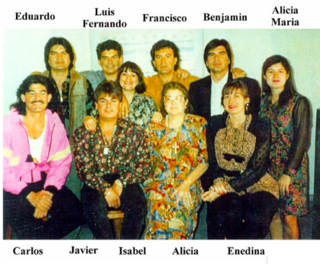
Eduardo Arellano Félix is a Mexican drug trafficker, brother of Benjamín, Ramón, Javier and sister, Enedina, all drug traffickers. The Arellano-Félix Organization, also known as the Tijuana Cartel, has been responsible for numerous murders and the smuggling of thousands of tons of marijuana, cocaine, heroin and methamphetamine for more than a decade. The DEA believes that the Arellano-Félix brothers were responsible for the numerous smuggling tunnels that were found in January 2006.

Juan García Abrego is a Mexican convicted drug lord and former leader of the Gulf Cartel, a criminal group based in the state of Tamaulipas, Mexico. He started in the cartel under the tutelage of his uncle Juan Nepomuceno Guerra.

The Sinaloa Cartel, also known as the Guzmán-Zambada Organization, the Federation, the Blood Alliance, or the Pacific Cartel, is a large, international organized crime syndicate based in the city of Culiacán, Sinaloa, Mexico that specializes in illegal drug trafficking and money laundering.
Operation Solare is the Italian name for a 2008 anti-drug operation involving the United States, Mexico, Guatemala and Italy, involving a major Mexican drug cartel, the Gulf Cartel, and the 'Ndrangheta mafia from the Calabria region of Italy. In the operation, some 200 people were arrested in Italy and in the US.
A drug lord, drug baron, kingpin, or lord of drugs is a type of crime boss, who is in charge of a drug-trafficking network, organization, or enterprise.

La Familia Michoacana, La Familia, is a Mexican drug cartel and organized crime syndicate based in the Mexican state of Michoacán. They are known to produce large amounts of methamphetamine in clandestine laboratories in Michoacan. Formerly allied to the Gulf Cartel—as part of Los Zetas—it split off in 2006. The cartel was founded by Carlos Rosales Mendoza, a close associate of Osiel Cárdenas. The second leader, Nazario Moreno González, known as El Más Loco, preached his organization's divine right to eliminate enemies. He carried a "bible" of his own sayings and insisted that his army of traffickers and hitmen avoid using the narcotics they produce and sell. Nazario Moreno's partners were José de Jesús Méndez Vargas, Servando Gómez Martínez and Enrique Plancarte Solís, each of whom has a bounty of $2 million for his capture, and were contesting the control of the organization.
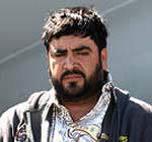
Alfredo Beltrán Leyva, commonly referred to by his alias El Mochomo, is a Mexican convicted drug lord and former leader of the Beltrán-Leyva Cartel, a drug trafficking organization. He was one of Mexico's most-wanted drug lords. Beltrán Leyva was responsible for smuggling multi-ton shipments of cocaine and methamphetamine to the United States from Mexico and South America between the 1990s and 2000s. He worked alongside his brothers Héctor, Carlos, and Arturo.
Memphis, Tennessee serves as the Southern headquarters for Tennessee based street organizations in the Southern United States. In 2021, there were approximately 102 gangs with 13,400 gang members in the city.

Óscar Malherbe de León is a Mexican imprisoned drug lord and former high-ranking leader of the Gulf Cartel, a criminal group based in Tamaulipas. He was the main intermediary of the Gulf Cartel in Colombia, responsible for shipping large sums of cocaine from the Cali Cartel in the 1990s. Before becoming a drug trafficker, Malherbe worked as a shoeshiner and car washer. He then turned to the auto theft industry and was recruited in 1976 by Casimiro Espinosa Campos, a former leader of a cell within the Gulf Cartel. By age 22, the Mexican authorities had charged Malherbe with at least 10 homicides. In 1984, Espinosa was killed by Juan García Abrego, then-leader of the Gulf Cartel, who later appointed Malherbe as one of his top lieutenants and moneymen.

Carlos Landín Martínez, also known as El Puma, was a Mexican former police chief and convicted drug lord. He was a high-ranking member of the Gulf Cartel, a criminal group based in Tamaulipas, Mexico, and worked as the second-in-command of the cartel in Reynosa from 2005 to 2007. Landín Martínez was a trusted enforcer of the kingpin Gregorio Sauceda Gamboa. Among his responsibilities included managing international drug trafficking shipments from Tamaulipas to Texas, collecting taxes from independent traffickers who operated in his turf, and managing money laundering operations. Landín Martínez was also a commander in the Tamaulipas State Police, where he headed the homicide taskforce. According to a witness who testified against him in court, Landín Martínez worked for the Gulf Cartel while still employed by the state police.
Gilberto Lerma Plata is a Mexican former police chief and convicted drug lord. He began his career in 1993 as a police officer in the Tamaulipas State Police when his cousin Manuel Cavazos Lerma became Governor of Tamaulipas. Lerma Plata was eventually promoted to police commander in Reynosa and Miguel Alemán. In the late 1990s, while still working for the police, Lerma Plata joined the Gulf Cartel, a criminal group based in Tamaulipas, for whom he facilitated drug trafficking operations from Mexico to the US, coordinated cash smuggling operations, and aided in the procurement of firearms.

Idalia Ramos Rangel is a Mexican business owner and suspected drug lord. According to the U.S. Federal Bureau of Investigation (FBI), she is a high-ranking member of the Gulf Cartel, a criminal group based in Tamaulipas, Mexico. In the cartel, Ramos Rangel is known by her aliases Big Momma and La Tía. She has reportedly been responsible for coordinating international drug trafficking shipments from Mexico to the United States since the mid-1980s. Her role in organized crime is unusual, as a woman active in the male-dominated Mexican drug trafficking industry over several decades.

Gilberto Barragán Balderas is a Mexican suspected drug lord and high-ranking member of the Gulf Cartel, a criminal group based in Tamaulipas, Mexico. He joined the cartel in the late 1990s and was a trusted enforcer of kingpin Jorge Eduardo Costilla Sánchez. Barragán Balderas was the regional boss of Miguel Alemán and helped coordinate international drug trafficking shipments from South and Central America to Mexico and the U.S. His role in the cartel also included providing them with information on the movement and location of Mexican security forces to ensure safe passage of their cocaine and marijuana shipments. In 2008, an indictment issued by the U.S. District Court for the District of Columbia detailing his criminal activities was unsealed in court.
Ediel López Falcón, also known as La Muela or Metro 5, is a Mexican convicted drug lord and former high-ranking member of the Gulf Cartel, a criminal group based in Tamaulipas, Mexico. He was the regional boss of Miguel Alemán and helped coordinate international drug trafficking shipments from South and Central America to Mexico and the U.S. His roles in the cartel were also to coordinate oil theft operations. In 2012, he was indicted by the U.S. District Court for the District of Columbia for drug trafficking activities. After fleeing Mexico to avoid gang-related violence, López Falcón was arrested in Texas during a sting operation in 2013. He pleaded guilty and was sentenced to 18 years in prison in 2015. He is currently imprisoned at the Federal Correctional Institution, Fort Dix in New Jersey. His expected release date is in 2029.
References
- 1 2 3 "Craig Petties". www.ClustrMaps.com. Retrieved March 20, 2023.
- 1 2 3 4 5 6 7 8 9 10 11 "Drug Trafficking Ringleader Craig Petties Sentenced To Life In Federal Prison". Department of Justice. March 19, 2015. Retrieved March 19, 2023.
- 1 2 3 4 5 6 7 8 9 10 11 12 Dries, Bill. "Drug Kingpin Petties Moved to New York". Memphis Daily News. Retrieved March 19, 2023.
- 1 2 3 4 5 6 7 8 9 10 11 12 13 14 15 16 17 18 19 20 21 22 23 24 25 26 27 28 Warren, Beth (August 25, 2013). "Wherever you put me, they'll kill me". The Commercial Appeal. Retrieved March 22, 2023.
- 1 2 3 4 5 6 7 8 9 10 11 12 13 14 15 16 17 18 19 20 21 22 23 24 25 26 27 28 29 30 Connolly, Daniel (June 27, 2010). "Blood Trade: The Story of Craig Petties". Pulitzer Center. Retrieved March 20, 2023.
- 1 2 3 Connolly, Daniel (June 27, 2010). "Blood Trade: The Story of Craig Petties". Pulitzer Center. Retrieved March 22, 2023.
- 1 2 Sainz, Adrian (February 14, 2012). "Cousins on trial in Memphis as hit men for Mexican drug ring". Baylor Lariat. Retrieved March 22, 2023.
- 1 2 3 4 5 Warren, Beth (February 16, 2012). "Killer cooly describes hit". The Commercial Appeal. Retrieved March 22, 2023.
- ↑ Scurlock, Stephanie (January 20, 2016). "Ruthless Drug Lord El Chapo helped Craig Petties move drugs onto Memphis streets". WREG. Retrieved March 22, 2023.
- ↑ Shoichet, Catherine E. (February 24, 2014). "'El Chapo' Guzman: How the world's most wanted drug lord was finally busted". CNN. Retrieved March 22, 2023.
- 1 2 3 Watkins, Greg (February 23, 2012). "DJ Paul's Half Brother Craig Petties Linked To BMF". All Hip Hop. Retrieved March 22, 2023.
- 1 2 3 4 5 6 7 8 Connolly, Daniel (July 4, 2010). "Blood Trade: Mexico was New Home for Alleged Drug Kingpin Craig Petties". The Commercial Appeal. Retrieved March 24, 2023.
- 1 2 Scurlock, Stephanie (August 22, 2013). "Drug Kingpin Craig Petties Gets Nine Life Sentences". WREG. Retrieved March 22, 2023.
- ↑ United States of American v. Demetrious Fields (13-5150); Clinton Lewis (13-5685); Martin Lewis (13-5907), U.S. ( United States Court of Appeals for the Sixth Circuit June 25, 2014).
- 1 2 Dries, Bill (February 16, 2012). "Jury Hears Recording of Hit Man Talking With Petties Target". Memphis Daily News. Retrieved March 21, 2023.
- 1 2 3 Dries, Bill (January 4, 2013). "Broady Gets 31 Year Sentence In Petties Case". Memphis Daily News. Retrieved March 21, 2023.
- 1 2 3 Warren, Beth (February 25, 2012). "Trial under way in one of largest, deadliest crime mobs in Memphis history". The Commercial Appeal. Retrieved March 24, 2023.
- 1 2 3 4 Dries, Bill (January 10, 2012). "Recordings Could be Played in Major Drug Trial". Memphis Daily News. Retrieved March 21, 2023.
- 1 2 Dries, Bill (February 2, 2013). "Fields Gets 37-Year Sentence in Petties Case". Memphis Daily News. Retrieved March 22, 2023.
- 1 2 3 Elkins, Chris (September 12, 2010). "Close to home". Daily Journal. Retrieved March 21, 2023.
- 1 2 Dries, Bill. "Petties Case Court Documents Suggest Post Conviction Plans". Memphis Daily News. Retrieved March 22, 2023.
- ↑ United States of American v. Demetrious Fields (13-5150); Clinton Lewis (13-5685); Martin Lewis (13-5907), U.S. ( United States Court of Appeals for the Sixth Circuit June 25, 2014).
- ↑ United States of American v. Demetrious Fields (13-5150); Clinton Lewis (13-5685); Martin Lewis (13-5907), U.S. ( United States Court of Appeals for the Sixth Circuit June 25, 2014).
- 1 2 3 Dries, Bill (March 6, 2012). "Petties Drug Trial Testimony Focuses on Defendants". Memphis Daily News. Retrieved March 21, 2023.
- 1 2 Dries, Bill (March 7, 2012). "Fed Drug Case Zeroes in on Defendants". Memphis Daily News. Retrieved March 22, 2023.
- ↑ United States of American v. Demetrious Fields (13-5150); Clinton Lewis (13-5685); Martin Lewis (13-5907), U.S. ( United States Court of Appeals for the Sixth Circuit June 25, 2014).
- ↑ "Clarence "Killer" Broady Sentenced To 372 Months For Drug Conspiracy, Violent Crimes". Department of Justice. March 19, 2015. Retrieved March 22, 2023.
- ↑ United States of American v. Demetrious Fields (13-5150); Clinton Lewis (13-5685); Martin Lewis (13-5907), U.S. ( United States Court of Appeals for the Sixth Circuit June 25, 2014).
- ↑ Connolly, Daniel (June 11, 2018). "'La Barbie,' reported partner of Memphis drug lord Craig Petties, gets 49 years in prison". The Commercial Appeal. Retrieved March 25, 2023.
- ↑ "Craig Petties". BOP.gov. Retrieved March 22, 2023.